Thursday, 11th August 2022
Israel-Palestine conflict - Edukemy Current Affairs
In News
A ceasefire between Israel and Palestinian militants has come to effect recently in a bid to end nearly three days of violence that killed dozens of Palestinians and disrupted the lives of hundreds of thousands of Israelis.
About the News:
- Israel had recently launched an airstrike operation against terrorists leading to the killing of second Islamic Jihad commander, Khaled Mansour and some civilians in southern Gaza.
- The subsequent retaliation by Iran-backed Palestinian Jihad militant group has led to flare-ups since the 11-day war between Israel and Hamas last year.
- Previously, Israel and Hamas have reached tacit understandings based on trading calm for work permits and a slight easing of the border blockade imposed by Israel and Egypt.
- The holy site of Jerusalem sits on the fault line of the Israeli-Palestinian conflict and is central to rival narratives of Palestinians and Israeli Jews.
- The tussle escalates the risk of the cross-border fighting turning into a full-fledged war unless a truce is achieved in near future.
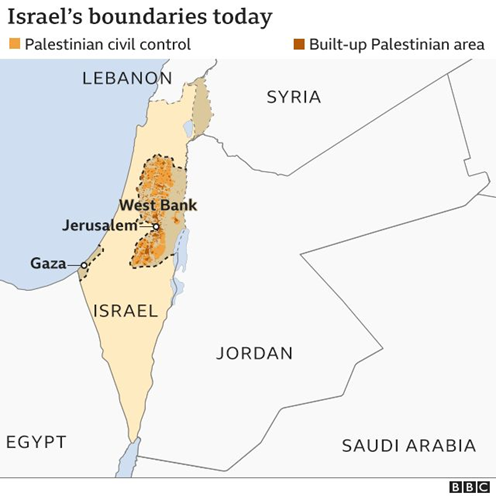
India’s Response:
- India has urged all parties to de-escalate the situation and resumption of talks between the Israeli and Palestinian during an emergency session at the UN Security Council.
- India has asserted that long time peace with Israel and Palestine can be achieved through negotiation on the Two-State Solution.
- Two-State solution is the establishment of a sovereign, independent and viable State of Palestine living within secure and recognized borders, side by side, at peace with Israel, taking into consideration the legitimate security needs of Israel.
- The UN resolution 181 of 1947, proposed Two-State-Solution which was later also agreed in the Oslo Accords of 1993.
India’s Israel-Palestine Policy:
- India voted against the creation of Israel in historic Palestine in 1947 in the UN General Assembly.
- During the Cold war era, India remained a strong supporter of Palestinian freedom, taking a moral and legal position against the Israeli occupation, in line with international laws and norms. India established full diplomatic relations with Israel in 1992.
- India established full diplomatic relations with Israel in 1992.
- In 2018, India adopted a de- hyphenation policy which meant that India’s relationship with Israel would stand on its own merits, independent and separate from India’s relationship with Palestine.
Source:
Image Source:
Coral Reef recovery in Great Barrier Reef (GBR)
In news
According to the recent report by the Australian Institute of Marine Science's (AIMS), the Great Barrier Reef continues to recover, registering the highest levels of coral cover recorded until now, in the Northern and Central regions over the past 36 years of monitoring.
Key findings of the report
- Over the past 36 years of monitoring by the Australian Institute of Marine Science (AIMS), coral reefs in the GBR have shown an ability to begin recovery after disturbances.
- While recovery continued on many Southern GBR reefs, regional coral cover declined slightly due to ongoing outbreaks of crown-of-thorns starfish in the Swain reefs.
- The combination of few acute stresses and lower accumulated heat stress in 2020 & 2022, compared to 2016-2017, has resulted in low coral mortality and has allowed coral cover to increase.
- In 2022, widespread recovery has led to the highest coral cover recorded by the programme, largely due to increase in the fast-growing Acropora corals, which are the dominant group of corals on the GBR.
- However, the GBR remains exposed to the predicted consequences of climate change, including frequent and intense marine heatwaves, risk of outbreaks of crown-of-thorns starfish and tropical cyclones.
- Simultaneously, chronic stressors such as high turbidity, increasing ocean temperatures and changing ocean chemistry can all negatively affect recovery rates.
- Above-average water temperatures led to a mass coral bleaching event over the austral summer of 2021/22, the fourth event since 2016 and the first recorded during a La Niña year.
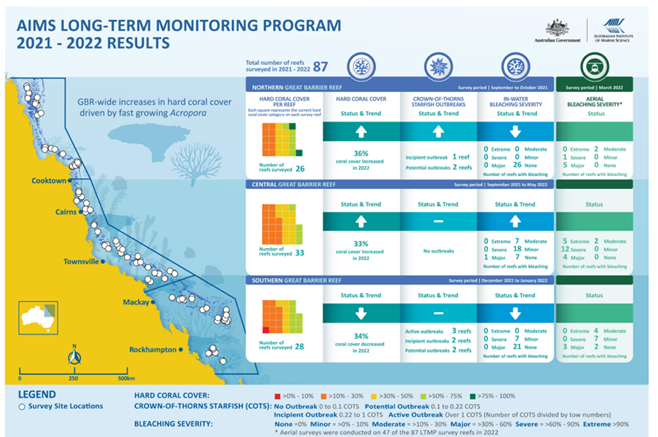
Sources:
- ANNUAL SUMMARY REPORT OF CORAL REEF CONDITION 2021/2022
- Explained | The Great Barrier Reef’s recovery and vulnerability to climate threats
Image Source:
New e-waste rules - Edukemy Current Affairs
In News:
The Union government has recently proposed new e-waste rules which according to some environmentalists will threaten jobs and collection network.
About the News:
- Electronic waste, or electronic goods that are past their productive life and old parts, is largely handled by India’s vast informal sector.
- To address this, the Ministry of environment has recently proposed a framework for regulating e-waste in India.
- The proposal has upset a key link of India’s electronic waste collection system and threatens the livelihood of thousands of people.
- Previously, the government has brought the E-waste (Management) Rules, 2016, which introduced a system of Extended Producer Responsibility (EPR) compelling makers of electronic goods to ensure a proportion of the goods they sold every year was recycled.
- The government has recently issued a draft notification that does away with the Producer Responsibility Organisations (PROs) and dismantlers and vests all responsibility of recycling with authorised recyclers, only a handful of which exist in India.
- The Central pollution Control Board is in charge of approving PROs, while the state pollution boards (PCBs) are authorised to issue licences to other players in the recycling chain.

Highlights of the new framework:
- About: Producer Responsibility Organisation or PROs are professional organisation authorised or financed collectively or individually by producers, which can take the responsibility for collection and channelisation of e-waste generated from the 'end-of- life' of their products to customers and generate electronic certificates.
- Bidding and Certification: The PROs typically bid for contracts from companies and arrange for specified quantities of goods to be recycled and provide companies certified proof of recycling that they then maintain as part of their records.
- Option of buying certificates: Companies can now buy these certificates equivalent to their annual committed target and thus do not have to be involved with engaging the PROs and dismantlers.
- Mandate of In-house: Under the new rules, recyclers will likely establish their own supply chains, and companies will no longer bear any responsibility for ensuring that their product is recycled.
- Dismantling of PROs: Centre has dismantled the existing system of PROs which used to provide checks and balances and was necessary because there is a lot of unauthorised recycling.
- Improving accountability: The new rules would rely on an electronic management system that would track the material that went in for recycling with the output claimed by a recycler when they claimed GST (Goods and Services Tax) input credit.
What are the major issues?
- Record maintenance: Companies are now expected to maintain records annually however most companies did not maintain an in-house unit in charge of recycling.
- Inherent risk: Several PROs have mailed their objections to the Ministry arguing that dismantling a fledgling system was detrimental to the future of e-waste management in India.
- Labour issues: Many of units are run out of unregulated sweatshops that employ child labour and hazardous extraction
- e-waste creation: Nearly 7 lakh tonnes of e-waste to have been generated in 2018-19 and around one million tonnes in 2019-20 of which only a fifth (about 22% in both years) has been confirmed to be “dismantled and recycled”.
- Problem of joblessness: Five years of investing and putting in place a system to collect and channel waste are under threat as 25,000 to 30,000 people were employed in this sector.
- Issue of double counting: The current system managed by PRO aren’t always reliable as there have been several instances of double-counting.
Source:
Image Source:
Taiwan’s “Porcupine Strategy” - Edukemy Current Affairs
- Context: Taiwan seems to focus on porcupine strategy to fight back China in case of any attack by the latter.
- The “porcupine doctrine”, is a strategy of asymmetric warfare focused on fortifying a weak state’s defences to exploit the enemy’s weaknesses rather than taking on its strengths.
- It was proposed in 2008 by US professor William S Murray.
- It is about building defences that would ensure that Taiwan could be attacked and damaged but not defeated, at least without unacceptably high costs and risks.
- This aims to make Taiwan’s defence so secure that any attacker faces a ruinous cost.
- Three defensive layers in this approach include:
- Outer layer is about intelligence and reconnaissance.
- Guerrilla warfare at sea.
- Innermost layer relies on geography and demography of island.
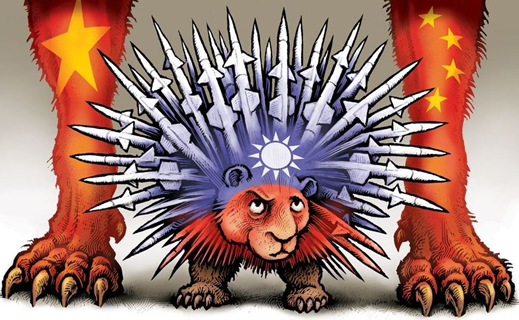
Source:
Image Source:
Blue Bond - Edukemy Current Affairs
- Context: SEBI has recently proposed the concept of blue bonds as a mode of sustainable finance.
- Blue bonds are a relatively new type ofsustainability bond which finance projects related to ocean conservation.
- Blue bonds operate similarly to any other debt instrument by providing capital to issuers who repay the debt with interest over time.
- Blue economy is the "sustainable use of ocean resources for economic growth, improved livelihoods, and jobs while preserving the health of ocean ecosystem".
- At present, the blue economy comprises 1% t of India's economy.
- Blue bonds offer an opportunity for private sector capital to be mobilized to support the blue economy.
- India can deploy blue bonds in various aspects of blue economy like oceanic resource mining, sustainable fishing, national offshore wind energy policy etc.
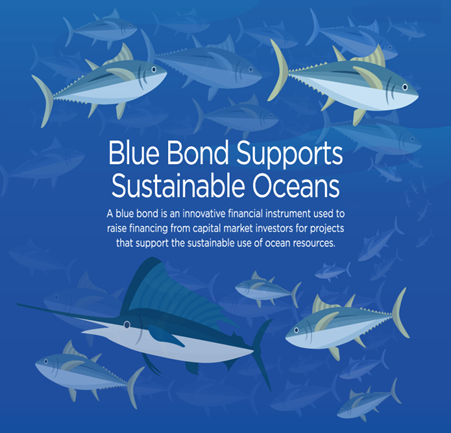
Source:
Image Source:
CSIR - Edukemy Current Affairs
- Context: Nallathamby Kalaiselvi has become the first woman director general of the CSIR.
- Council of Scientific and Industrial Research (CSIR)is the largest research and development (R&D) organisation in India whose president is the Prime Minister of India.
- It hasa pan-India presence and has a dynamic network of 37 national laboratories, 39 outreach centres, 3 Innovation Complexes and 5 units.
- It was established in September 1942 and is headquartered in New Delhi.
- CSIRis funded by the Ministry of Science and Technology and it operates as an autonomous body through the Societies Registration Act, 1860.
- CSIR covers a wide spectrum of streams – from radio and space physics, oceanography, geophysics, chemicals, drugs, genomics, biotechnology and nanotechnology to mining, aeronautics, instrumentation, environmental engineering and information technology.
- It provides significant technological interventionin many areas with regard to societal efforts which include the environment, health, drinking water, food, housing, energy, farm and non-farm sectors.
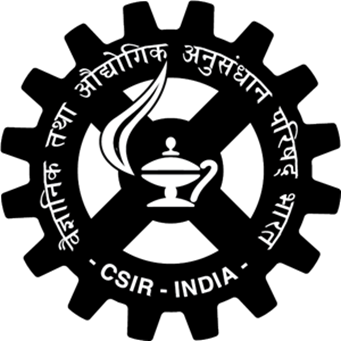
Source:
Image Source:
Cantillon Effect - Edukemy Current Affairs
- Context: This term was seen in news recently.
- The Cantillon effect refers to the idea that changes in the money supply in an economy causes redistribution of purchasing power among people, disturbs the relative prices of goods and services, and leads to the misallocation of scarce resources.
- Although, money has largely been considered to be neutral by economists today, in the sense that changes in its supply have no real effect on the economy.
- The Cantillon effect is named after the 18th century French economist Richard Cantillon who published his ideas in the 1755 book Essay on the Nature of Trade in General.

Source:
Image Source:
The inequality challenge for India@75: Livemint
Essence- The article highlights that the three giant nations of South Asia – India, China, and Indonesia have gained freedom almost together in the late 1940s, and then moved on to the path of development simultaneously. However, the case of India is curios with the most marked inequality, with the divide between rich and poor, being the highest in the region.
As per World Inequality Report 2021, the top 1% in India held 33% of the total wealth; while the bottom 50% had a mere 6% of the total wealth. The report highlights stark inequality and the need for us to introspect and reflect on the issue, while we celebrate 75 years of independence.
There is also a divide in the development of states. The western and southern states have developed at a faster pace, while northern and eastern states are lagging behind. Further, absolute poverty in India has declined since the 1980s but is still high. This could have been minimized further if the dividends of growth were evenly distributed in society.
Why should you read this editorial?
- The article provides data points related to growth and development in Indian society since independence.
- The article gives insights into the benefits of bridging the economic divide in the country.
Source:
Incorporate State OBCs in Central List
Essence –The article discusses about the reservation system provided for OBC communities. It compares this with its SCs and STs counterpart. After giving the brief description of the evolution OBC reservation through various commissions and Supreme court judgements, it has highlighted the systemic fault in the identification of OBC at state and union level.
At the end it recommends that before going for any further subcategorization among the OBCs Govt. should first ensure that these communities are proportionately represented in all government services and institution specially the coveted ones. To ascertain this there caste census needs to be conducted.
Why should you read this editorial?
- To know about the history of reservation in our country.
- To develop an idea whether sub categorisation in needed now or later.
Source:
Maharashtra Village: A Lesson in Jal Jeevan Mission
Background
Pimpalghar-Ranjnoli, a village in Maharashtra has used funds under the Jal Jeevan Mission (JJM) to ensure that all 842 families in the village get tap water connection.
About Jal Jeevan Mission (JJM)
- Jal Jeevan Mission, is envisioned to provide safe and adequate drinking water through individual household tap connections by 2024 to all households in rural India.
- The programme will implement source sustainability measures as mandatory elements, such as recharge and reuse through grey water management, water conservation, rain water harvesting.
- The Jal Jeevan Mission is based on a community approach to water and will include extensive Information, Education and communication as a key component of the mission.
- Key objectives of mission are to provide functional tap connection to every rural household, Schools, Anganwadi centres, GP buildings, Health centres, wellness centres and community buildings.
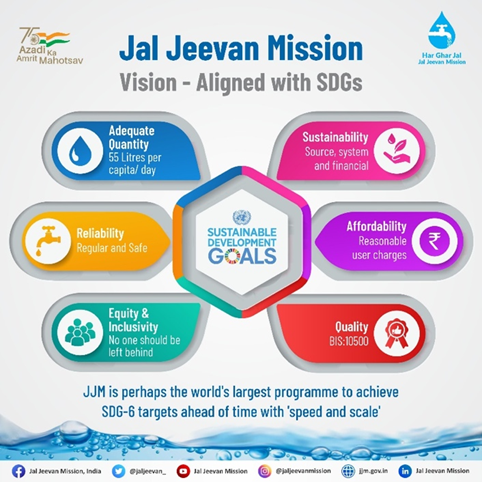
About the Model Village
- While Pimpalghar-Ranjnoli can stand out as a model for the rest of the country, the efforts by the state government to implement JJM should be highlighted.
- Of the planned schemes under JJM, Detailed Project Reports (DPRs) for 84% of the schemes are ready.
- Works below Rs 5 crore were executed at Zilla Parishad (ZP) level, while those above were carried out by Maharashtra Jeevan Pradhikaran (Water Supply and Sanitation Department, Maharashtra)
- Further, the state had appointed a project management consultant to execute schemes.
- Also, the decentralisation of the work involved various organisations and agencies at the district level to prepare village-centric plans.
- The goal is to deliver 55 litres of water daily to each person of every household by 2024.
Source:
Image Source:
Share the article
Get Latest Updates on Offers, Event dates, and free Mentorship sessions.

Get in touch with our Expert Academic Counsellors 👋
FAQs
UPSC Daily Current Affairs focuses on learning current events on a daily basis. An aspirant needs to study regular and updated information about current events, news, and relevant topics that are important for UPSC aspirants. It covers national and international affairs, government policies, socio-economic issues, science and technology advancements, and more.
UPSC Daily Current Affairs provides aspirants with a concise and comprehensive overview of the latest happenings and developments across various fields. It helps aspirants stay updated with current affairs and provides them with valuable insights and analysis, which are essential for answering questions in the UPSC examinations. It enhances their knowledge, analytical skills, and ability to connect current affairs with the UPSC syllabus.
UPSC Daily Current Affairs covers a wide range of topics, including politics, economics, science and technology, environment, social issues, governance, international relations, and more. It offers news summaries, in-depth analyses, editorials, opinion pieces, and relevant study materials. It also provides practice questions and quizzes to help aspirants test their understanding of current affairs.
Edukemy's UPSC Daily Current Affairs can be accessed through:
- UPSC Daily Current Affairs can be accessed through Current Affairs tab at the top of the Main Page of Edukemy.
- Edukemy Mobile app: The Daily Current Affairs can also be access through Edukemy Mobile App.
- Social media: Follow Edukemy’s official social media accounts or pages that provide UPSC Daily Current Affairs updates, including Facebook, Twitter, or Telegram channels.

